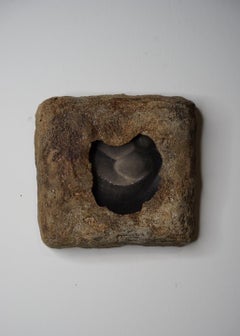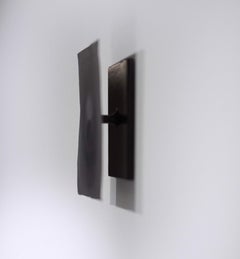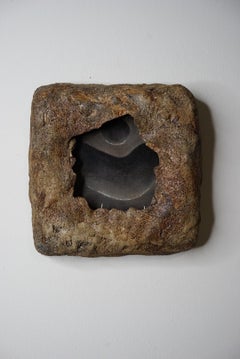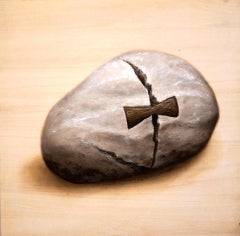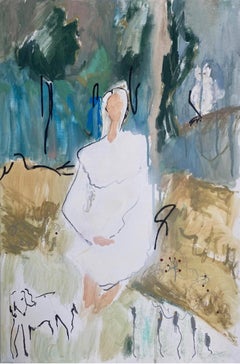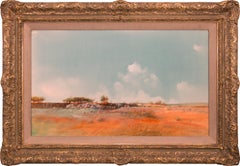Oda Art
to
4
4
2
"Excavation 2" Oil Painting
By Oda
Located in Denver, CO
Oda's (CAN based) "Excavation 2" is an oil painting that depicts dark interior shapes revealed .
Artist Bio/statement:
Corey ‘Oda’ Popp is an emerging Japanese-American contemporar...
Category
2010s Abstract Oda Art
Materials
Linen, Oil, Panel
Cone Illusion
By Oda
Located in Denver, CO
Cone Illusion
Category
21st Century and Contemporary Oda Art
Materials
Steel
$375
"Excavation 1" Oil Painting
By Oda
Located in Denver, CO
Oda's (CAN based) "Excavation 1" is an oil painting that depicts dark interior shapes revealed .
Artist Bio/statement:
Corey ‘Oda’ Popp is an emerging Japanese-American contemporar...
Category
2010s Abstract Oda Art
Materials
Oil, Panel, Linen
Paper beats Rock
By Oda
Located in Denver, CO
Paper beats Rock
Category
21st Century and Contemporary Oda Art
Materials
Oil, Wood Panel
Related Items
Forest fog, 60x40cm, acrylic, pastel, canvas
Located in Yerevan, AM
Forest fog, 60x40cm, acrylic, pastel, canvas
Category
2010s Neo-Expressionist Oda Art
Materials
Canvas, Pastel, Acrylic
$703 Sale Price
25% Off
H 23.63 in W 15.75 in
"Flat Lands" Original Landscape Mixed Media on Paper by Tom Perkinson, Framed
By Tom Perkinson
Located in Encino, CA
"Flat Lands" is an original mixed media on paper by Tom Perkinson. His use of saturated violets, vivid yellows, and resplendent oranges pushes color to almost-otherworldly realms. Th...
Category
1970s Realist Oda Art
Materials
Pastel, Ink, Mixed Media, Watercolor, Color Pencil
$5,500
H 26.625 in W 38.375 in D 2.5 in
Portrait of a Gentleman, Doublet & White Ruff, Gloves Inscribed 1624, on panel
By Frans Pourbus the Younger
Located in London, GB
Titan Fine Art presents this exquisite oil on panel portrait depicting a handsome young gentleman in an exuberant black damask doublet. The pose, with one hand holding gloves and the other akimbo, was one that was well-established for gentleman of the upper echelons of society by the time this work was painted. The principle governing portraits at this time was the recording and defining in visual terms of the position of a sitter in society. In addition to brilliant and complex symbols of luxury, they often contained many symbolic elements too; the inclusion of gloves was often used in portraits that celebrated a betrothal as in ancient times gloves were used to seal a marriage contract.
The extraordinary costume of a black shimmering doublet, the brilliant white reticella ruff, and the cuffs edged with lace were immensely costly… this attire proclaims to every onlooker that this is a superior being. The rendering of the reticella lace ruff is exquisite and the artist has recorded the design that runs through the black damask fabric with meticulous attention to detail. The preservation of this black pigment is remarkable considering the age of the work. Black pigments are especially vulnerable to fade and wear over time partly due to environmental condition but also from unprofessional cleaning. This work is an exquisite example from the period.
According to the inscription in the upper right, the gentleman was in his 22nd year of age in 1624. The coat of arms, which is displayed without a crest, may be ‘blazoned’ in the language of heraldry, as: Sable on a Chevron between in chief two Roundels and in base a Billet [or possibly Square] Or three Martlets Sable. In plainer English this means a black (Sable) background, spanned by a gold (Or) chevron, above which are two golden solid circles (Roundels), and below which is a gold rectangle (Billet); on the chevron are three small black birds (Martlets). Martlets are a stylised form of heraldic bird, believed to be based on the swift, which are conventionally drawn with small tufts instead of feet. In Continental Europe it is also conventional for them to be drawn without beaks, as appears to be the case here. The birds in this instance also have a vaguely duck-like appearance.
Five families have been identified with very close armorial bearings to the one in our portrait. They are the (van) Houthem’s (of Brabant), the Prévinaire’s (of Flanders and Holland), and the Proveneer’s (of Liège) and it must be noted that the locations of these families also fit with the painting’s Flemish origins. However the French Grenières’s (of Île-de-France) and the Jallot’s (of Normandy) are the next closest matches and plausible matches, as Frans Pourbus had settled in Paris just a few years before our portrait was painted.
This painting has been assessed by a professional conservator prior to going on sale, and as thus, it can be hung and enjoyed immediately.
Frans Pourbus the Younger...
Category
17th Century Old Masters Oda Art
Materials
Oil, Wood Panel
$17,737
H 42.13 in W 31.11 in D 3.94 in
"Plains Indian Camp" Lrg Original Mixed Media on Paper by Tom Perkinson, Framed
By Tom Perkinson
Located in Encino, CA
"Plains Indian Camp" is an original mixed media on paper by Tom Perkinson. His use of saturated violets, vivid yellows, and resplendent oranges pushes colo...
Category
1980s Realist Oda Art
Materials
Pastel, Ink, Mixed Media, Watercolor, Color Pencil
$8,000
H 32.625 in W 43.125 in D 1 in
Still Life with a Blue Vase , 70x50cm, paper/ pastel/ gouache
By Aleksandra Mato
Located in Yerevan, AM
Still Life with a Blue Vase
70x50 cm
Category
2010s Contemporary Oda Art
Materials
Paper, Pastel, Gouache
$750 Sale Price
25% Off
H 27.56 in W 19.69 in
All Good Cowboys Have Chinese Eyes
By Michael David
Located in Phoenix, AZ
encaustic on panel
b. 1954, Reno Nevada
Michael David is best known for his use of encaustic on large abstract paintings. A practitioner of Abstract Expressionism, David layers bees...
Category
2010s Color-Field Oda Art
Materials
Wax, Encaustic, Wood Panel, Oil
"Reflections in the Pond" Large Mixed Media on Board by Tom Perkinson, Framed
By Tom Perkinson
Located in Encino, CA
"Reflections in the Pond" is an original mixed media on board by Tom Perkinson. His use of saturated violets, vivid yellows, and resplendent oranges pushes color to almost-otherworld...
Category
1970s Realist Oda Art
Materials
Ink, Color Pencil, Watercolor, Mixed Media, Pastel
$6,500
H 31.875 in W 43.5 in D 2.875 in
"1940 - Number Nine" Original Mixed Media on Board by Tom Perkinson, Framed
By Tom Perkinson
Located in Encino, CA
"1940 - Number Nine" is an original mixed media on board by Tom Perkinson. His use of saturated violets, vivid yellows, and resplendent oranges pushes colo...
Category
1980s Realist Oda Art
Materials
Pastel, Ink, Mixed Media, Watercolor, Color Pencil
$3,500
H 20.5 in W 32.5 in D 1.125 in
Dutch Old Master Portrait of Maurits, Prince of Orange-Nassau, Oil on Panel
Located in London, GB
In 1607, the Delft city council decided to commission a portrait of Stadholder Maurits of Nassau for the town hall, with Michiel van Mierevelt as the chosen artist due to the passing...
Category
17th Century Old Masters Oda Art
Materials
Oil, Wood Panel
$11,578
H 37.8 in W 33.47 in D 2.37 in
Sea , 40x30cm, paper/ pastel
By Aleksandra Mato
Located in Yerevan, AM
Sea
40x30 cm
Category
2010s Contemporary Oda Art
Materials
Paper, Pastel
Maya Kabat, Super Spatial 4, Oil on Canvas on Panel, 2019
By Maya Kabat
Located in Boston, MA
Artist: Maya Kabat
Title: Super Spatial 4
Medium: Oil on canvas on panel
Size: 22x12 inches
Year: 2019
Price: $2000
Category
2010s Abstract Oda Art
Materials
Canvas, Oil, Panel
Letter to the Sixth Poet - 40x120 oil on canvas diptych - serene luxury
By Gail Chase-Bien
Located in Burlingame, CA
Contemplative, rich, Turner-esque warm bronze abstract Impressionist reflective scene alludes to light falling on a vast landscape or body of water. Created with a rich range of gold...
Category
21st Century and Contemporary Abstract Impressionist Oda Art
Materials
Canvas, Linen, Oil, Panel
$32,000
H 40 in W 120 in D 2.25 in
Oda art for sale on 1stDibs.
Find a wide variety of authentic Oda art available for sale on 1stDibs. You can also browse by medium to find art by Oda in oil paint, paint, panel and more. Much of the original work by this artist or collective was created during the 21st century and contemporary and is mostly associated with the abstract style. Not every interior allows for large Oda art, so small editions measuring 5 inches across are available. Oda art prices can differ depending upon medium, time period and other attributes. On 1stDibs, the price for these items starts at $300 and tops out at $475, while the average work can sell for $425.
